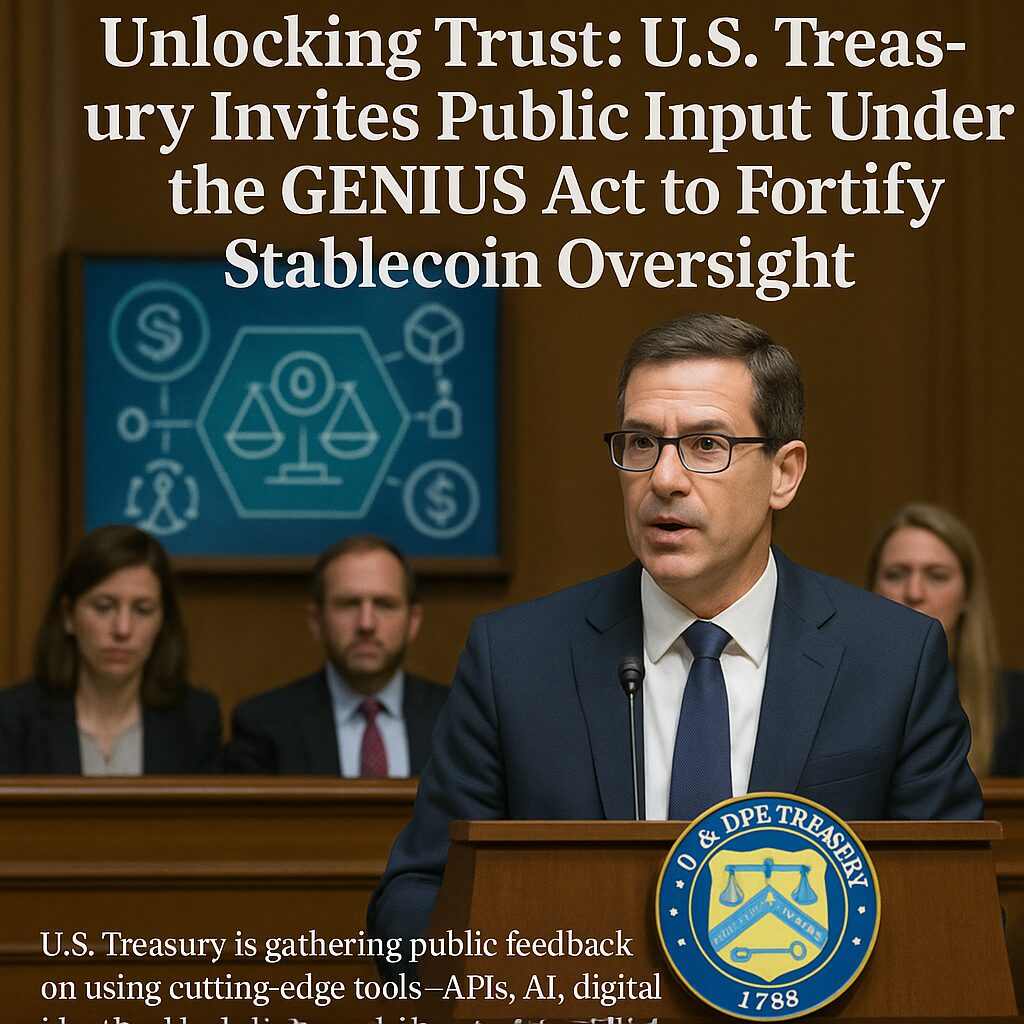
Key Takeaways:
- U.S. Treasury is gathering public feedback on using cutting-edge tools—APIs, AI, digital identity, blockchain analytics—to detect illicit digital‑asset activity.
- The GENIUS Act, enacted on July 18, 2025, establishes the first comprehensive federal framework for U.S. dollar‑backed stablecoins.
- Major institutions are preparing to launch stablecoins, though significant challenges remain around compliance, infrastructure, and use case design.
- Critics warn of unintended consequences, such as complications in bankruptcy protections and increased systemic risk.
- Stablecoins’ regulation under this Act could boost demand for U.S. Treasuries and reshape digital finance—but careful implementation is essential.
1. An Invitation for Innovation: Public Feedback on Combating Illicit Activities
On August 18, 2025, the U.S. Treasury Department launched a public comment process, fulfilling a requirement of the newly enacted GENIUS Act. They seek views on innovative or novel methods for detecting illicit activities—such as money laundering—involving digital assets. Key areas of interest include application programming interfaces (APIs), artificial intelligence (AI), digital identity verification, and blockchain‑based monitoring tools.
Treasury will analyze public input, factor in considerations such as effectiveness, privacy, cybersecurity risks, cost, and operational challenges, and then provide findings to Congress and potentially develop further regulations.
Comments are due by October 17 on regulations.gov—offering practitioners, developers, and stakeholders a chance to shape oversight frameworks.
2. The GENIUS Act: A New Era for Stablecoin Governance
Signed into law by President Trump on July 18, 2025, the GENIUS Act—short for “Guiding and Establishing National Innovation for U.S. Stablecoins”—institutes the first federal-level regulation for payment stablecoins in the United States.
It mandates:
- One-to-one backing of stablecoins with U.S. dollars or similarly low-risk assets.
- Transparency via monthly reserve disclosures and annual audits for large issuers (e.g., those with market caps over $50 billion).
- Compliance with anti‑money laundering and Bank Secrecy Act provisions, designating stablecoin issuers as financial institutions.
3. Market Momentum and Implementation Challenges
Following the law’s enactment, major financial institutions—including Bank of America, Citigroup, Walmart, and Amazon—are strategizing for stablecoin issuance.While banks have advantages with established compliance systems, non-bank players face complex decisions around infrastructure, blockchain platform choice, and regulatory burden.
Analysts foresee adoption will be gradual, as firms assess whether to issue their own tokens or integrate with existing options, and align issuance with clear use cases—retail payments, institutional settlement, or cross‑border transfers.
4. Unintended Outcomes: Bankruptcy Protections and Systemic Implications
A notable feature of the GENIUS Act is enhanced protection for stablecoin holders in the event of issuer insolvency. Reserve assets are excluded from bankruptcy estates, giving token holders super‑priority over all creditors—even ahead of tax claims and employee wages.
Though protective for users, this provision may undermine the issuer’s ability to reorganize via Chapter 11, possibly triggering immediate liquidation due to lack of access to reserve funds—posing a serious unintended consequence.
5. Broader Economic and Financial Dynamics
Stablecoins now enter a new phase—regulated, transparent, and potentially mainstream. Analysts suggest the law could bolster demand for U.S. Treasuries, with projections of up to $1 trillion in market growth over three years.
However, critics caution against potential risks such as systemic instability, undermining traditional banking functions, and the return of quasi-private money systems. At present, their economic influence is largely contained within financial markets, with limited retail footprint.
6. What This Means for Blockchain Practitioners and Crypto Entrepreneurs
For blockchain developers, crypto-native firms, and fintech innovators:
- The public comment period is an open window to influence oversight technologies. Propose scalable, privacy-preserving, and secure solutions for AML and fraud detection.
- Issuance strategies must align with compliance requirements—whether backing assets, technology stack, or audit readiness.
- Risk managers should be aware of regulatory nuance: stablecoins are now treated as financial instruments, with attendant obligations.
- Startup founders should monitor regulatory developments to position offerings for interoperability and alignment with compliance standards.
Conclusion
The GENIUS Act marks a watershed for U.S. digital asset regulation: it brings structure, transparency, and credibility to stablecoins while opening the door to broader institutional adoption. The Treasury’s request for public feedback on detection technologies is a particularly practical step toward integrating innovation with oversight. Yet, complex challenges—bankruptcy frameworks, compliance burdens, infrastructural choices—must be navigated carefully.
For innovators, the path ahead is one of collaboration and strategic design: to build systems that are both compliant and forward-looking. Stablecoins may now be guided by law—but their future will be shaped by those who understand how to merge practicality with regulation.

